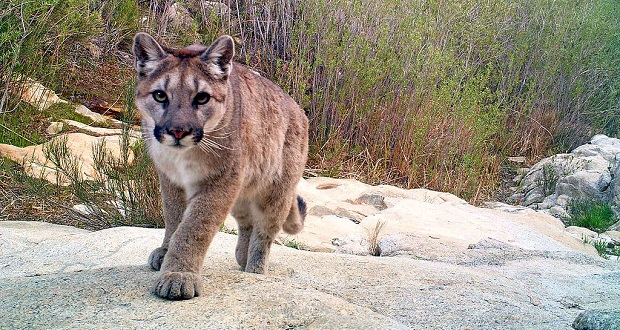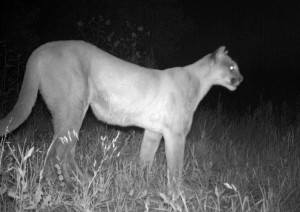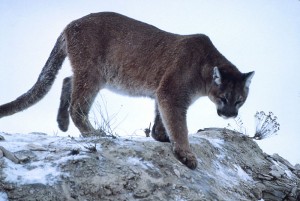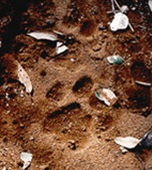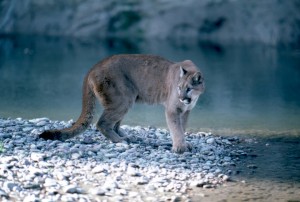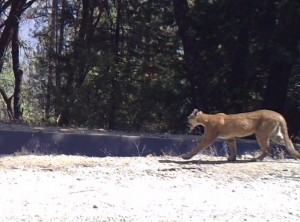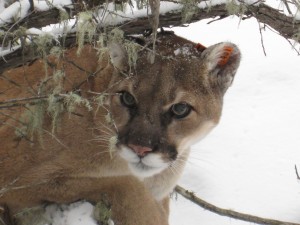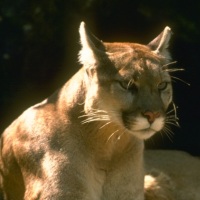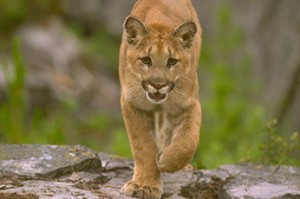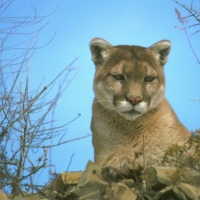by Kellie Flanagan
COARSEGOLD — Not long after sunset on a cold December night, a call was made from Deadwood Lookout to wildlife specialist Randy Partch. “The lion is in the trap,” said the homeowner.
For Partch, a trapper contracted annually by Madera County, this was good news. He’d just set the lion’s trap that morning, after five goats were killed the night before. This wasn’t the first time livestock had been taken around that part of the foothills. Dozens of goats had been attacked over the course of a year, and it was a fact known by locals: an active lion was in the neighborhood. But what, at that time, was known about the lion?
Mountain lions, Puma concolor, have roamed the Americas for some 40,000 years at least, and can be found from sea level to over 14,000 feet elevation. Humans commonly live among the elusive cats known also as cougars and pumas, yet the creature remains a mystery in some ways.
You may not have seen a mountain lion but, chances are if you walk or hike in the forest nearby, a mountain lion has seen you.
Even so, a plain fact like the number of mountain lions that inhabit this very region can be difficult to pin down.
“We can’t make a reliable estimate of lion numbers for a specific area without a current investigation, because lion numbers fluctuate over time due to a number of factors,” explains Tim Kroeker, the California Department of Fish and Wildlife (CDFW) biologist assigned to Madera County. The number of lions is related mostly to prey availability and migration in and out of areas, and even interstate movements, he says
“Back in the 1980s a research project estimated about one lion per 20 square miles in eastern Fresno County. Many researchers think the lion numbers have dropped significantly since then.”
We may not know exactly how many mountain lions are in the foothills, but in terms of life cycle, we know that mountain lions can be born anytime of the year. The majority, says Kroeker, are probably born in the late summer through fall.
Lion cubs are born in a pattern that “follows the peak in births for deer a couple of months earlier. This makes sense because it means more prey availability.” The average size of a litter is two or three kittens, born blind and toothless, that nurse for about 40 days. They start with fluff and spots that fade as they grow older.
“I would expect a lion to stay with its mother for the first year and disperse sometime late in the second year,” says Kroeker. “A sibling group might stick together for several months after dispersing from their mother. Females reach reproductive age at about two and a half years.”
With an average lifespan of eight to thirteen years, a cougar might be considered old by the age of ten. Young males may not make it to old age, since it often means fighting dominant males for a territory of their own.
Territory can best be explained, say experts, by thinking about how humans live in a house. You may spend most of your time in a few rooms of your home, and less time in your backyard. A mountain lion spends most of its time in a 10 to 20 square mile area: that’s their house. The totality of their territory, when it comes to hunting and mating, could range to more than 100 miles. That would be considered their backyard. We live in their backyard.
“Lions are always present in the foothill/populated portion of Eastern Madera County,” Kroeker confirms. “The migrations of deer in the spring cause some lions to migrate with them but they return when the deer do in the late fall.”
Cougars hunt with efficiency, usually alone, between the hours of dusk and dawn. They can bound forty feet while running, or leap 15 feet up into a tree. An adult male mountain lion can weigh well over 150 pounds, yet climb over a 12-foot fence, and sprint to speeds of 50 miles per hour. Even a small cougar can weigh 80 or 90 pounds. The cougar attacks from behind, locking powerful jaws on prey in such a way as to crush the esophagus quickly, smothering the animal with rapid force. If deer are not available, and livestock is, the lion will take advantage of the opportunity.
The vast majority of interactions between humans and mountain lions are sightings, say experts. If livestock is killed by cougar, Fish and Wildlife wants to know.
That’s what was happening within a five mile radius of Deadwood Lookout all the way over to Road 425B, says trapper Randy Partch, in spring and summer of 2015, and again more recently.
Partch said last June that a homeowner in the area had reportedly lost about 25 goats since May. The same mountain lion, it was presumed, also struck on 425B, and was said to have taken a total of about 40 goats this year, by early summer.
How could one predator take so much prey?
Partch says it’s like putting ten mice in a box and adding a cat. The mice scurry around, the cat’s predatory instincts kick in and it kills all the mice quickly, and then, maybe, eats one mouse. The lion’s behavior is similar: it jumps over the fence into an open-air pen and the scared goats run; the lion does what lions do and kills the goats.
This is why Partch strongly recommends that people who own animals lock them up tight, and refrain from leaving livestock in an open pen or corral.
The mountain lion has been a specially protected mammal in California since 1990, when voters passed Proposition 117 which helped protect habitat and banned the trophy hunting of mountain lions in the state. This status and other statutes prohibit the California Department of Fish and Wildlife from recommending a hunting season for lions, and it is illegal to take, injure, possess, transport, import, or sell any mountain lion or part of a mountain lion.
Legally, mountain lions may be killed only if a depredation permit is issued to take a specific lion killing livestock or pets, or to preserve public safety, or to protect listed bighorn sheep.
Depredation permits must be issued by the CDFW and the permits are good for only ten days. While the CDFW issues the permits, they do not carry out the trapping or killing of a problem animal. That agency is the U.S. Department of Agriculture (USDA). Other than permitted residents under special circumstances, only certified trappers with specific experience and the proper permit can attempt to trap or kill wildlife that is perceived as a threat to livestock or humans.
Randy Partch has been trapping and dealing with errant animals for nearly thirty years.
Some people wonder why he doesn’t use dogs to track the mountain lions in Madera County. Partch explains dogs are not an option when it comes to hunting mountain lions in the area, and is impractical, because traversing through private property requires permission from owners. The relatively small parcels in the neighborhood mean nothing to a mountain lion that doesn’t give advance warning of its whereabouts. This particular strike was close to CA-41 and the surrounding properties are smaller than a mountain lion’s territory.
Moving what may be considered a problem mountain lion is not an option, for a few reasons, say experts. Lions are known to become erratic when hit with a dart, and relocation has the potential to cause deadly conflicts with other mountain lions already living in the new area. This particular lion was a predating animal that was used to foraging, says Partch, and if it were moved could spread disease and create a situation where it affects more animals. Another scenario is that the relocated mountain lion returns.
Partch repeats that killing a mountain lion is the last resort, but that’s what it came down in the last week of 2015, when a depredation permit was issued for the Deadwood Lookout area mountain lion that had repeatedly preyed on goats. Partch was frustrated because he was having a hard time correcting the problem, he says, of this particular mountain lion repeatedly attacking livestock.
“This lion had returned to the scene of previous kills and evidenced a pattern, making it a nuisance in the eyes of the homeowners, who suffered repeated loss of livestock.”
Sometime overnight on Tuesday, Dec. 29, the mountain lion entered the enclosure through a wood panel, attacking the homeowner’s livestock in the barn, killing five goats. The lion carried one across a fenced enclosure, covered it and partly fed on it.
Permit in hand, Partch set a special trap with a live goat, knowing that the mountain lion they were looking for would prefer moving prey, compared with the carcass it had stashed away.
The carefully-fabricated trap is about four feet tall, four feet wide, and seven feet long. Live bait like the goat goes on one side, where there’s a removable door and a partition. They removed the carcass the lion had been working on. The way the trap works, the lion can’t get to the goat, but thinks it can. Partch set the trap and left it, with not much expectation of success or failure, either way. He’d been down this road, literally, before.
Instead, Partch received the call that evening, sooner than he had anticipated. “The lion is in the trap.”
The homeowner reported that the lion had gone after the bait, and was caught. It was exposing its belly and twisting from side to side, they said. That behavior seemed unfamiliar to Partch, who has seen lions trapped before and says they are more likely to be unsettled, bouncing and pacing, not showing behavior that housecats would exhibit in order to be petted.
In the end, the lion was euthanized on site by someone on the property who had a weapon who was confident they could do the job. It was a bullet to the brain, Partch says, which is considered humane.
The next morning, Partch came into Coarsegold to pick up the lion from the residents at 8 a.m. and drove out to Friant where he turned it over to the California Department of Fish and Game.
A necropsy was subsequently performed to study tissue samples, check for disease, and make a definitive determination of weight and age. Madera County Wildlife Biologist Tim Kroeker reports that the lion was approximately six to seven years old and healthy.
“The liver looked normal and there was no indication of disease in this lion. There have been documented cases of lions being exposed to and debilitated by anti-coagulants, which are widely used in illegal grows. We do send tissue samples including liver to the Wildlife Investigation Lab, which they use for various research but analysis is typically months down the road.”
When stories about mountain lions reach the news, readers sometimes comment that all the fires and drought the state has experienced could be pushing animals out of their regular habitat. Not necessarily, Kroeker explains.
“It makes sense that fire would displace wildlife temporarily but it would displace them into the remaining habitat not necessarily to populated areas. Having watched deer behavior following the Rim Fire I would expect the deer to move onto their own winter home range whether it was burned or not and most of the winter range in Madera county has not burned. Also most of the recent fires in Eastern Madera County have been in and adjacent to populated areas. Perhaps the more open conditions of post fire habitat make wildlife more easily detected.”
Kroeker believes it’s important for residents of foothills to know that, locally, mountain lion density and attacks are relatively low. Still, it’s important to be cautious with livestock and kids.
“People can protect their pets and livestock from lions by securing them in a shed or barn with secure doors, windows and a roof at night,” says Kroeker. “Lion attacks on people are rare but people should take certain precautions while living or playing in areas with lions. We recommend avoiding walking running or playing alone in low light conditions and keeping the area around your house well lit and clear of dense brush. Also if you are hiking with children or pets don’t allow them to run on ahead but keep them near you.”
Emphasizing that lions are opportunistic when it comes to feeding, Kroeker explains that lions have a prey image, and typically that means a four-legged animal about the size of a deer. While a mountain lion may attack livestock, that’s probably not what it went looking for to begin with. If a lion returns to prey on livestock from the same place, that’s just convenient fast-food.
“If lions locate sheep or goats while they are hunting they will kill them because they superficially resemble deer. All animals develop patterns for looking for food in areas where they found it before, people too as far as that goes,” Kroeker adds.
“Personally, I am habituated to stop at Bass Fork for a Pepsi if I am anywhere near it. Some lions become habitual killers of livestock and they are not likely to change their habits.”
Both trapper Partch and biologist Kroeker agree that the best approach residents can take is to be practical, prepared, and keep prey out of the way of predators.
And when it comes to mountain lions, “you live in their country,” Partch reminds, “and they make up the rules.”
Keep Me Wild (CDFW) – Mountain Lion
Verified Mountain Lion Attacks On Humans (CDFW)
Depredation Permits Issued By County (CDFW)
Investigations on the Status of the California mountain lion (1972)
Mountain lion kittens in the Santa Monica Mountains, study underway

